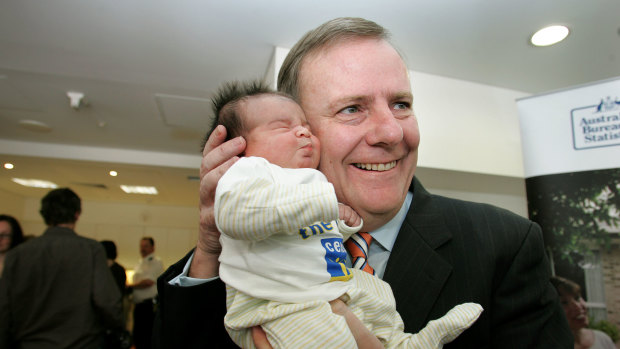This was published 1 year ago
Population boom caught the Howard government by surprise
By Shane Wright
The Howard government was warned of huge budget and financial problems due to the nation’s low fertility rate and a rapidly ageing population that would require a substantial lift in tax revenues and far-reaching economic reforms.
But the warnings were based on a major miscalculation of how the nation’s population would grow, underestimating by 2.5 million the number of people who would call Australia home by the early 2020s.

Peter Costello announced the first version of the baby bonus in 2002 as the Howard government worried about how to deal with Australia’s demographic issues.Credit: Sandy Scheltema
Cabinet papers from 2002 released on Sunday by the National Archives show the deep concerns within John Howard’s government about the economic challenges posed by a slowdown in the nation’s population growth and Australia’s ageing profile.
Then-treasurer Peter Costello had that year released the first intergenerational report, which sought to map out how the budget would change over the coming 40 years. He had also announced the government’s signature baby bonus policy which originally provided up to $2500 a year to parents for five years.
In a discussion paper entitled “Addressing Australia’s Changing Demographics” presented to cabinet in December, Costello said that while the country did not yet face a population “crisis”, policy decisions had to start being made because of looming financial problems.
“A consequence of Australia’s ageing population is that the rate of growth of Australia’s potential labour force is declining and will eventually fall to zero in around 40 years’ time,” he said.
“Plausible projections suggest that to maintain living standards, and to meet the inevitable fiscal challenges, the economy’s potential could need to be increased by upwards of an additional 20 per cent over the next 40 years.”
Those projections included very low population growth. Between 2002 and 2022, Australia’s population was projected to climb from 19.6 million to 23.2 million.
Instead, population data released in December showed there were 25.7 million Australians in the country. While the original projections were accurate around the number of people aged over 65, they underestimated the number of younger Australians by 2.5 million.
Tasmania’s population was projected to start falling from 2001, while South Australia would have fewer residents from 2030, and Victoria and the ACT from 2040.
Instead, Tasmania’s population has grown by 7 per cent, South Australia has added almost 300,000 residents while Victoria is home to 2 million more people.
The main reason for the vast underestimation of Australia’s population was an assumption that net overseas migration would average 100,000 over the next 40 years.
But migration has soared. In 2019, net overseas migration for the year had reached 260,000.
The global financial crisis in 2008-09 also caused a surge in the number of Australians who returned home because of the poor economic outlook in countries such as the United States and Britain.
The workforce participation rate, which has reached a record high over the past six months, was expected to fall while there were concerns older Australians would not stay in work because of ongoing health problems. But the number of people over the age of 65 in the workforce has continued to grow.
The assumptions around the workforce and the stagnant population led to a string of proposals from Treasury and other departments on how to lift overall economic growth.
They included industrial relations reform, health programs aimed at keeping people in work for longer, reductions in effective marginal tax rates for lower-paid Australians and overhauling superannuation including the age at which people could access their retirement savings.
The Industry Department, in comments about the Treasury document, noted “incremental changes to the age pension system and tax concessions for the self-funded retirees have reduced the projected savings to the budget and the introduction of the superannuation guarantee and the tax concessions provided to superannuation”.
Those changes included special one-off payments to pensioners that effectively became permanent elements of the welfare system and a string of superannuation tax concessions introduced by Costello between 2002 and 2007.
Cut through the noise of federal politics with news, views and expert analysis from Jacqueline Maley. Subscribers can sign up to our weekly Inside Politics newsletter here.